Nokia N86 8MP review: Lens wide open
Lens wide open
The 8MP wide-angle camera sounds exciting but needs tuning up
Nokia N86 8MP, as the name suggests, sports an 8 megapixel camera, which is probably its key selling point. It sports a maximum image resolution of 3264x2448 pixels and boasts Carl Zeiss lens as usual for the Nokia cameraphone flagships.
Hardware
The 28mm (in 35mm terms) wide-angle lens, autofocus and dual-LED flash it is some pretty pretty impressive equipment as far as hardware is concerned. A xenon flash would have left very little more to be demanded but we guess Nokia doesn't favor those anymore.
However being the first handset to feature 28mm lens, the Nokia N86 8MP is still guaranteed to excite every proper geek out there. For those of you unfamiliar with the material we will explain that the 28mm lens gives you roughly 20 percent larger angle of view when looking through the viewfinder.
To make this advantage even more obvious, here's a collage illustrating the framing difference between a regular cameraphone and the wide-angle Nokia N86 8MP.

28mm vs 35mm lens angle of view
The wide-angle lens is especially useful when taking landscape and architecture photos as you don't need to go as far back to fit the whole subject in the frame.
On the negative side wide-angle lens aren't as suitable for photographing portraits from close range as people's faces turn out unnaturally distorted. It's not that 35mm is that great for making portraits either but 28mm is even worse.
Another disadvantage of the 28mm lens is that fitting more stuff in the same frame means that the things in it are actually smaller (described by fewer pixels, if you wish) and if you don't need the extra angle of view you are loosing some scene detail.
Mind you, all other things equal, we would take a 28mm wide angle cameraphone any day - it's just seems more suited for all-purpose walk-around uses.
Another cameraphone innovation found on the Nokia N86 8MP is its variable aperture. It's not technically a first since the Motorola Motozine ZN5 was the pioneer here but it's still rare enough.
In layman's terms, theory says the variable aperture allows the camera to choose either the benefit of better-than-standard light sensitivity or better-than-standard sharpness throughout the photo.
And to use the proper terminology, Nokia N86 8MP shoots at F/2.4 to let more light in low-light conditions and stops down to F/3.2 or F/4.8 when light conditions allow it. Technically the photos at smaller apertures (indicated by a larger F-stop value) should be sharper and with larger depth of field than photos shot by any other 8 megapixel cameraphone on the market.
Unfortunately Nokia didn't give the users any kind of manual control over the aperture value and it is all automatic. We are not saying that such an option will be used too much but why not give the occasional enthusiastic user the choice.
And finally, the N86 8MP camera also has a mechanical shutter (much like Samsung i8510 INNOV8, Nokia N73, Sony Ericsson K800 and K850). As a mechanical way of stopping light making its way to the sensor, it takes care of the vertical stripes that appear in the highlights of high-contrast images also known as smear, as well as the wavy distortion that sometimes appears if you move the camera while shooting.
User interface and features
The camera UI of Nokia N86 8MP is the same as the one back in N85. It offers extensive settings - starting from manual white balance and ISO sensitivity (up to ISO800) and including exposure compensation, sharpness and contrast settings. Various effects are also at hand, labeled color tones. You can also customize the toolbar by deciding which options to appear and in what order.
Another nice camera feature is geotagging, which by the way, works with videos, too. GPS locks are comparatively fast but you still might want to wait about a minute before your first shot.
An area where the Nokia N86 8MP disappoints compared to its rivals is camera features. We aren't talking about settings here but rather about those nice little perks that almost all midrange point-and-shoot cameras sport for quite a while now.
In other words, there is no face recognition, blink detection or smile recognition. Not to mention the 120fps and time-lapse video recording modes found on the competing handsets. This is not an issue big enough to ruin the whole deal but it is nice to have them onboard a camera flagship.
At least the panorama mode is present and it works pretty good. It automatically detects the direction in which you are rotating the camera and takes the shots at the required interval. The size of each individual shot is 1280 x 860 pixels but some of it gets wasted due to the vertical movement of the camera.
Still we managed to make a 3-shots panorama with a height of almost 800 pixels which is pretty impressive stuff. And with the 28mm lens 3 shots are probably the most that potential users are ever going to need.
The Nokia N86 8MP also offers a nicely customizable time-laps stills shooting mode that lets you leave the phone on a nice vantage point and have it shoot at custom intervals for as long as you want. The resulting photos can be compiled into some really nice looking videos if you have the little technical knowledge needed to process them on a computer later on.
Image quality
We did notice that the Nokia N86 8MP camera has some issues with the processing algorithm when we published our initial preview but now that we've gathered more samples, we are pretty certain there are some major flaws there. There are a lot of strange artifacts when rendering text and some are even evident on our test resolution chart (more on that later).
As usual the best way to judge a cameraphone performance is to compare it to another one of the kind. The choice went naturally to the Samsung i8510 INNOV8, which is easily one of the best 8 meagapixel cameraphones released to date.
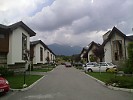
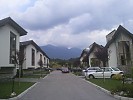


Nokia N86 8MP • Samsung i8510 INNOV8 • Nokia N86 8MP • Samsung i8510 INNOV8
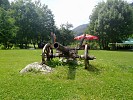

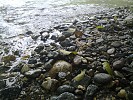
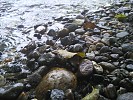
Nokia N86 8MP • Samsung i8510 INNOV8 • Nokia N86 8MP • Samsung i8510 INNOV8
The Samsung handset has obvious advantage over the Nokia N86 8MP in terms of fine detail (fits less in the frame so uses more pixels to describe the same subjects) and its image processing is much more mature with no artifacts present. Even if you neutralize the larger field of view disadvantage by physically moving forward to shoot from closer distance with the Nokia than with the INNOV8, the N86 8MP still fails to resolve as much detail as the INNOV8.
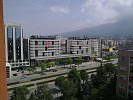
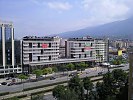
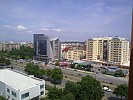
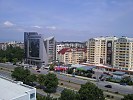
Nokia N86 8MP • Samsung i8510 INNOV8 • Nokia N86 8MP • Samsung i8510 INNOV8


Nokia N86 8MP • Samsung i8510 INNOV8
The noise reduction is also much more aggressive in the N86 8MP results, eradicating all fine detail and giving the photos a distinct oil-painting look. The photos however aren't any less noisy than the INNOV8, which either means that the N86 sensor isn't as good in this aspect or the algorithm is a total failure. Either way, the Samsung INNOV8 snatches a point here as well.
The dynamic range seems about equal on both handsets and so is the color balance. The INNOV8 has gone way off with the purple flower, which looks blue in its photo, while the Nokia reproduces the yellow building slightly more yellow than it actually is.

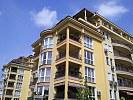
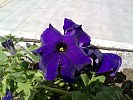
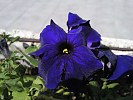
Nokia N86 8MP • Samsung i8510 INNOV8 • Nokia N86 8MP • Samsung i8510 INNOV8
We also noticed that the Nokia N86 is too easily susceptible to lens flare, resulting in washed out images in situations when the sun has been just about to peek in your frame.
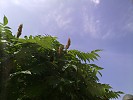
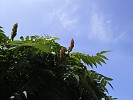
The Nokia N86 8MP image quality deteriorates even when the sun is just outside the frame
And here go some more Nokia N86 8MP samples for you to enjoy:
Synthetic resolution
Finally it comes the time for our studio resolution chart. This is a standard ISO12233 chart used for evaluating the synthetic resolution of digital cameras. It is an excellent tool for measuring pure horizontal and vertical resolution and also offers a good reference point for comparison of resolution between cameras.
We have also added a few touches of our own to the chart by sticking a color chart and a grey scale over it. The first one will allow you to see the amount of noise in the different colors as it tends to vary quite a lot from phone to phone depending on the sensor and the noise reduction technique applied.
The gray scale is there to provoke the usually more powerful noise reduction, which kicks in when shadows are involved. Once that happens, you will notice complete loss of detail towards the darker end of the scale.
Meanwhile the thin lines at the top of both the color chart and the gray scale illustrate the real-life effect of the noise reduction. You will notice that the numbers are barely readable with some phones and more easily recognizable with others.
Snapping the chart with Nokia N86 8MP revealed the advantage it has over the 5 megapixel Nokia N97. It's tough to say which one is better when you compare it to the INNOV8 but it seems that the N86 has the slightest of advantages.
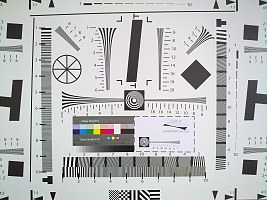

Nokia N86 8MP resolution chart photo • 100% crops


Samsung i8510 INNOV8 resolution chart photo • 100% crops

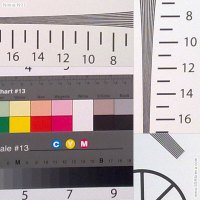
Nokia N97 resolution chart photo • 100% crops
What that means is that the disadvantage the Nokia N86 8MP has in the real life scenarios is due to the flawed processing (which kicks in only in some cases) rather than permanent imperfections such as poor lens optics or design. We are just hoping that Nokia will make an effort to fix it with a firmware update - it won't be the first time we see that happen.
28mm add fun to video recording
As for video recording, the N86 8MP camera shoots in the now-midrange VGA resolution at 30fps. Videos are captured in MP4 format and can have automatic or manual white balance. The other available settings are night mode, exposure and color effects. You can also choose whether the dual-LED flash should be turned on to act as a video light.
Leaving the fact that VGA is no longer top-of-the-ladder achievement aside, the quality of the videos is pretty good. There is plenty of resolution and the details are nicely sharpened. The colors are also well reproduced and the 28mm lens adds a really nice touch to the videos. The perspective changes more than one might expect and the resulting videos are quite interesting.
Reader comments
- AnonD-572864
- 16 Aug 2016
- 7tK
Very nice set
- Anonymous
- 12 Jan 2011
- 3Ir
best phone ever, king of 8mp, the first wide-angle lens, it Rocks baby
- Rajesh Pratap
- 01 Oct 2010
- t@J
Comparison between Nokia and Sony ericsson (SE) : I bought SE W995 two weeks ago after going behind the highly over lighted advertisement of SE w995. And now, I replaced with Nokia n86_8mp. I’m discribing the details that happened between this 2 we...




















